Bicycles have come a long way since their humble beginnings as two-wheeled transport for people on foot. Thanks to improvements in technology and design, today’s bikes are powerful and comfortable enough for anyone to ride.
Despite a wide array of benefits, bicycles continue to face some significant challenges. One such very common challenge is “how to measure a bike stem length?”. Now you may think how a small stem would be a problem.
Some might wonder why we need to measure stem length at all. While few would have come here looking for precise measurements of bike stems. No matter which category you fall into, this article is for you.
So, come on, let’s talk about this smallish bicycle stem, its important role in your bicycle, and most importantly, how to measure it.
What is a Bike Stem
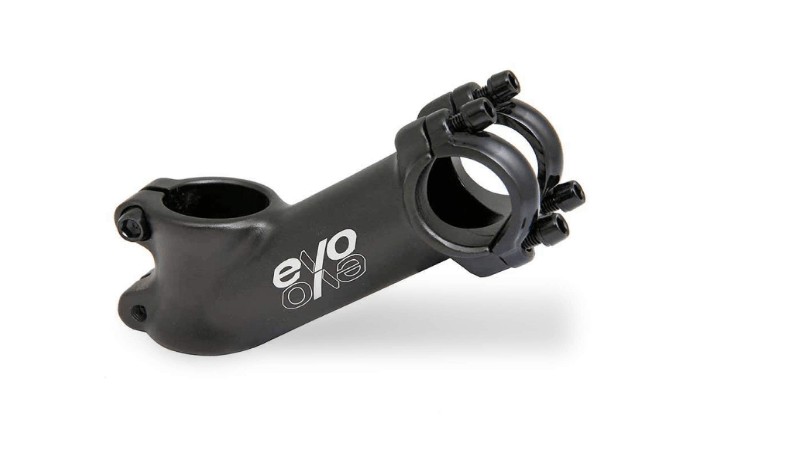
The Bike Stem is a part in between the handlebars and the steerer tube of the bike. This very important component makes sure that your arms are level and that you can keep balance.
If the bike stem’s angle is not set right, you’ll suffer from arm fatigue and difficulty keeping balance.
Most bikes come with a stock stem that’s already adjusted to a comfortable angle, but if you’re not happy with the way your bike rides, there are a few things you can do to adjust it yourself.
You can try changing the stem’s angle by degrees either by twisting the bolt that holds it in place or by loosening and tightening the clamping screws. The amount of adjustment you make will depend on how stiff or flexible your steerer tube is.
If you’re uncomfortable riding with a stock stem, it’s worth investing in a quality aftermarket one that will give you the perfect fit for your body and style of cycling. It’s also important to make sure that your bike doesn’t jiggle, which can be caused by a weak or broken stem.
How Stem Length Affects Bicycle Performance
Bike stem length is important because it affects how the bike handles.
A too-shorter stem causes the bike to lean towards the front wheel and makes it harder to stay in the saddle, plus provides a more upright position, while a too-longer stem makes it hard to reach the pedals with your feet.
Stems come in different lengths for a reason: You need enough leverage to push against the ground and turn the pedals, but you also want your hands close to the handlebars for control.
Typically, mountain bike stems range from 35mm to 80mm, gravel bike stems range from 80mm to 100mm, and road bike stems range from 90mm to 140mm. Some riders prefer shorter stems to increase agility and responsiveness, while others may find a longer stem more comfortable over long distances.
It’s important to choose the right stem length for your bike and body type to achieve the optimal riding experience. A proper size stem for your bike will fit comfortably in your hand and allow you to move the handlebars easily.
When choosing a bike stem, it’s important to measure your frame’s length and compare it to the specifications provided by the manufacturer. A good rule of thumb is to choose a stem that’s about 1 inch longer than your frame’s length.
Glossary to Bike Stems Terminology
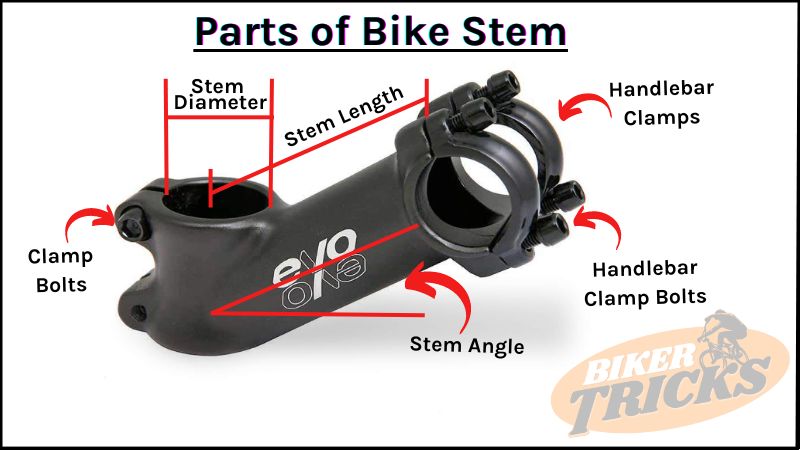
1. Stem Rise
This term refers to the angle that the stem makes with the fork’s steerer tube, which affects how the bike is positioned and how far forward it can reach.
Stems with zero rises, for example, are essential ‘straight,’ while stems with a rise of 10° have an angle of 10° between steering and handlebar clamps.
The majority of stems have a moderate rise, of 6°, which is the most common, and can be flipped to give a low bar position if needed.
For a balance of pedaling comfort and handling response, you may also need to experiment with stem rise.
However, for the ideal cockpit positioning, you can also use handlebar rise, spacers on the steerer tube, etc., in addition, to stem the rise.
2. Bike Stem Length
Bike stems play a big role in how you handle your bike and what you feel while riding, so it’s important to get a stem that fits your needs properly.
A too short stem makes the bike unstable and hard to control, while a too-long stem can make the bike difficult to ride. Hence, choose based on your expertise level.
3. Stem Clamp Design
Stem clamp design is one of the most important factors when it comes to bicycle performance. The more sturdy and stiff the stem clamp is, the less you need to worry about cramps setting in.
A good stem clamp will have a strong metal frame that can hold the stem in place securely without causing any pain or discomfort. You should also look for a stem clamp that can be easily tightened and undone, so you can make quick adjustments if needed.
Additionally, make sure that the handlebar clamp diameter has enough room to accommodate different stem sizes. If your item is on the wider side, opt for a clamp with a larger opening.
Also, be sure to ask your retailer about their specific recommendations. They’ll be able to help you find the perfect fit for your bike and riding style.
4. Top Tube Length
There is no clear answer when it comes to the top tube length – what matters most is how comfortable you feel on your bike.
However, some general guidelines can help you estimate the negative rise of an MTB frame. The negative rise is the distance from the ground to the top tube of the bike.
A shorter top tube will result in a higher negative rise, while a longer top tube will result in a lower negative rise.
Generally, a 50 mm to 80 mm MTB stem length is optimal for a comfortable ride. For those with especially long torsos, going even longer may be necessary to ensure adequate clearance below the seat.
5. Bike Stem’s Angle
When it comes to the right bike stem angle, different riders have different preferences. However, by sticking to an angle of 5 to 6 degrees, you’ll be good to go. There are a few reasons why this angle is an excellent choice for you. First of all, it ensures that your hands are in a comfortable position when you’re riding.
If your item is too high or too low, it will be difficult to hold onto the handlebar correctly. You’ll also find that you’re more efficient at pedaling when your stem is in an appropriate position.
Another reason to stick with a 5 to 6-degree angle is safety. If your stem is angled too high or low, you may end up hitting your head on the frame or other obstacles while you’re cycling.
By keeping your stem at a fairly standard angle, you’ll reduce the chances of getting injured in any way.
6. Stem Diameter
The stem has two diameters that must be considered when selecting the stem for your bike.
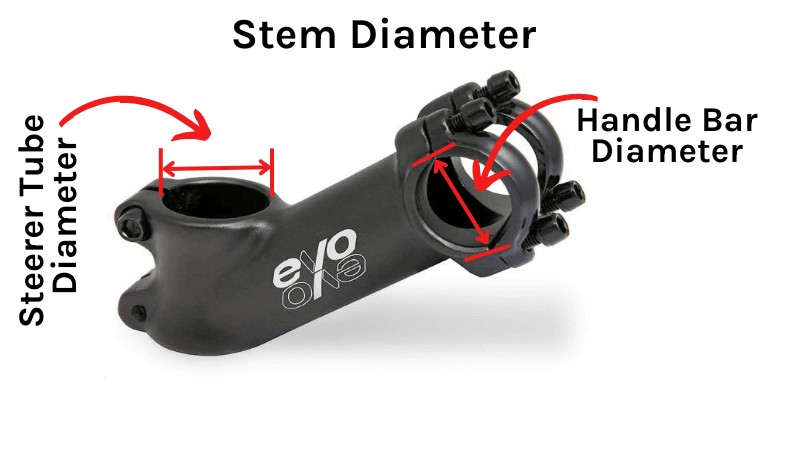
a. Steerer tube diameter
Stems must be sized correctly to match the dimensions of the steerer tube of a fork. There are mainly two common sizes of steerer tubes available on the market: 1″ and 11/8″.
Threadless stems should be chosen by the outside diameter of the steer tube; in this case, a reducing shim may be used if the 11/8″ stem is to be fitted with a 1″ steer tube.
Conversely, a quill stem must be sized to fit the steer tube’s inner diameter. To fit an 11/8″ steer tube, a quill stem is made with an outer diameter of 1″.
b. Handle Bar Diameter
The more rigid the handlebar, the more stable the bike will be in the hands.
Another factor to consider when selecting bike handlebars is how they affect your posture on the bike. If you are slouching or resting your hands on your stomach, a stiffer bar will push your shoulders back and help you maintain an upright position.
Conversely, if you are sitting up tall with your arms extended, a softer bar will allow your arms to dip lower and increase the risk of fatigue over time. So, be wise while making your decision.
Both threadless and quill stems come in a variety of clamp diameters for bicycle handlebars.
By ISO standards, the clamping area of a handlebar should be 25.4 mm (1 inch). This size is often used on mountain bikes and some road bikes.
The “7” shape of quill stems made identifying a road stem easy in the past, but nowadays, it’s hard to tell the difference between a “road” stem (26.0 mm) and an “MTB” stem (25.4 mm).
It is common for BMX bikes to have clamps with a diameter of 22.2 mm.
7. Fork Steerer Tube
A fork steerer tube is a tube that runs between the fork blades and the handlebars to keep the bike from wobbling. The steerer tube diameter helps transfer road vibrations from the fork blades to the handlebars, which reduces fatigue on your hands and arms.
Types of Stem Materials
Stems can be made from aluminum, carbon fiber, steel, or titanium. Among all materials, aluminum is the most commonly used one. It is very lightweight, good in a pocket, and, most importantly, very durable.
Stems made from steel are also cheaper but heavier, while stems made from carbon and titanium are lighter but cost a lot more. Aside from saving weight, carbon fiber also dampens vibrations on the road.
Note: The carbon stem may appeal to you since it is quite an exotic material. But the thing to keep in mind is that carbon fiber does not seem to offer any great advantages over aluminum alloy for stems, besides the fact that it is considerably more expensive.
So, it is better to stick with aluminum stems, which are used by most professional riders as well.
The most common types of Bike Stems
There are a variety of different types of bike stems, each with its advantages and disadvantages. Some stem types are specifically designed for mountain biking, while others are more suited for road riding.
Here is a look at the seven main stem types:
1. Quill Stems
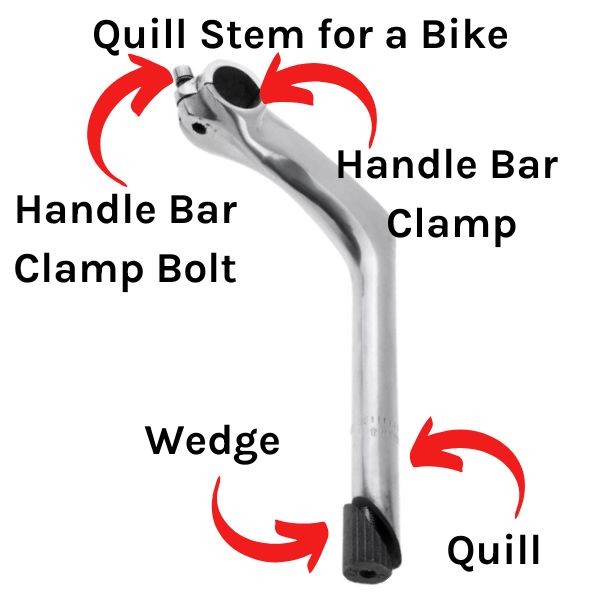
Back in the day, bikes were all about simplicity. There were no cables to deal with, no derailleurs to fuss with, and absolutely no need for a suspension fork. All you needed was a sturdy frame, a set of gears, and your trusty pair of handlebars.
One of the key features of these old-school bicycles was their quill stems. This stem design made for a very stable bike ride – even when you were pushing it a bit – and it also gave these bikes a nice tone of confidence and excitement.
Many riders credit the quill stem with being one of the main reasons why old-school bikes are so fun to ride. A quill stem is not necessarily bad, and in some cases, it can offer an advantage.
For example, they can provide a more durable frame due to the added weight of the quill stem. Additionally, quills tend to be stiffer than other stems, which can make them better for heavier riders.
However, quills do have some drawbacks. For one, they require heavy steerer tubes, and the headset needs to be a bit kinky. This means that you will likely need to sell different-sized forks to use a quill stem.
Moreover, because quills are so stiff, they limit your choice of forks. This can create challenges when trying to ride multiple types of terrain or when climbing steep hills. Overall, while quills do have their limitations, they have proven themselves over time as one of the strongest stems on the market.
2. Threadless Bike Stems
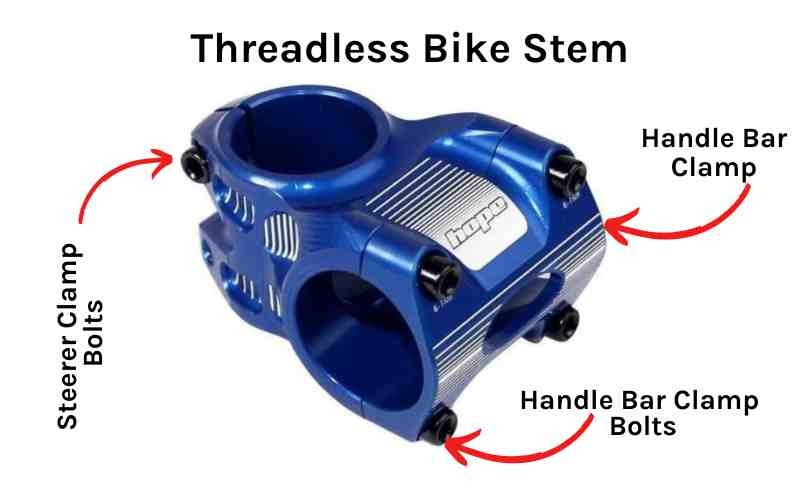
There’s a new way to do stems on bikes, and it’s called the “threadless” system. This design extends the non-threaded steer tube through the head tube. This gives your bike an extremely clean look, as well as improved geometry and responsiveness.
Threadless headset stems offer plenty of advantages for riders. For one, it eliminates the risk of your bike falling off if it has a weak or faulty attachment point at the head tube.
Additionally, Threadless stems are often lightweight and more nimble than their threaded counterparts, making them perfect for fast-paced riding or mountain biking. If you’re looking for an upgrade that’ll give you an even better ride, consider investing in a threadless stem.
3. Mountain Bike Stems
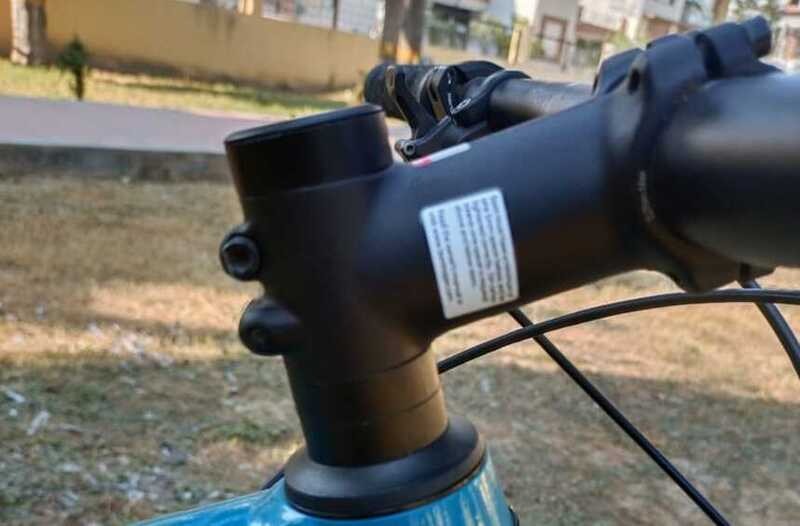
Mountain bikes usually have shorter bike stem diameters. This makes them more robust and easier to handle on the mountain, where tight turns and tricky descents are commonplace.
It’s also a feature that allows riders to take advantage of the bike’s inherent agility to fly down hills. The shorter stem also creates a more responsive ride, making it easy to snap the bike around corners or up steep terrain.
The downside of this stem design is that it can make it harder to stay balanced while riding since the rider has less stability when looking forward.
Additionally, shorter stems can be more susceptible to damage in crashes, as they are less likely to absorb impact completely. For these reasons, many mountain bikers prefer road bikes over mountain biking for everyday use.
4. Road Bike Stems
Road bikes are typically equipped with longer stems and more upright handlebars for more comfort when riding on paved roads. This position is often referred to as an “aerodynamic” position because it allows the rider to achieve a lower center line of gravity and thereby reduce wind resistance.
The aerodynamic position also makes the bike easier to ride in a straight line, which is especially important on long stretches of road.
Whether you’re commuting to work or hitting some scenic routes around town, road biking is an excellent choice for your transportation needs. All credit goes to its longer stem that provides stability.
5. Gravel Bike Stems
Newer gravel bikes typically have stems that are a bit shorter than those found on road bikes, usually 80mm or less. This is for a few reasons: first, shorter stem lengths allow for more maneuverability when riding on gravel roads and trails.
Secondly, the shorter stem works better with the slacker headtube angles popular on modern gravel bike designs; and lastly, because most gravel bikes don’t have rear suspension, a longer stem would only add weight and complexity to the bike.
So if you’re looking for an upgrade that will improve your Riding Experience on all types of terrain – road, dirt, and even mountain biking – consider upgrading to a newer model with a shorter stem. You won’t be disappointed.
6. BMX Stems
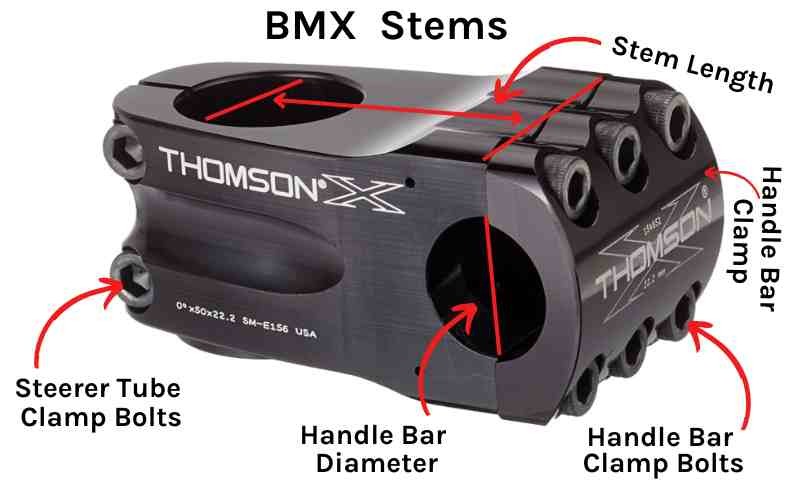
BMX riders have always been known for their daring stunts and acrobatic maneuvers. But what many people don’t know is that they owe a lot of their success to the long, sturdy stems on their bikes.
Stems on BMX bikes are often much longer than those on traditional bicycles, which gives riders more leverage when doing tricks. This extra length also makes it easier to stay balanced while riding since you’re not constantly leaning into the turns.
In addition, the heavy-duty construction of BMX stems can handle a lot of abuse. They’re often made from steel or aluminum, which means they can take a beating when you’re crashing into barriers or other obstacles.
So if you’re looking for a bike that’s perfect for daredevil shows and high-grip street racing, be sure to check out a BMX frame with a long stem.
7. Direct Mount Mountain Bike Stems
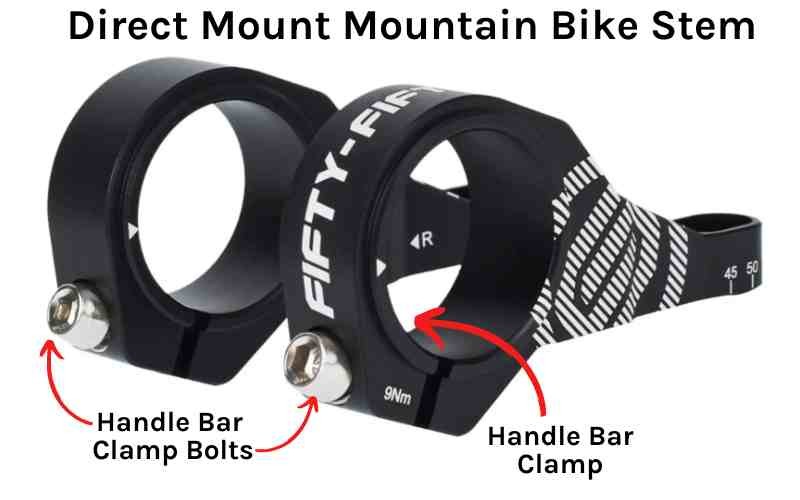
This particular stem is specifically designed to offer an extreme level of strength and stiffness that simply cannot be achieved with a normal bicycle stem. It is specifically designed for dual crown bikes intended for downhill and freeride mountain biking.
Furthermore, the increased durability and steering with this stem provide more precise and controlled riding at high speeds.
Direct-mount bike stems have the same design as motorbike stems and bolt directly to the fork crown. Plus, they are primarily determined by their clamp diameter and stem length.
Most clamps have a diameter of 31.8mm or 35mm, with the larger size having a slightly stiffer feel but also slightly heavier. Another caveat is that the handlebar diameter must match your chosen diameter, whatever diameter you choose.
Direct mount stems typically measure 40-50mm in length, but longer and shorter options are also available.
Like with standard stems, the length of the direct mount mountain bike stem will have a straight effect on the overall feel of the bike as well as your fit on the bike.
How to measure Bike Stem Length
People usually think about the length of the stem from the front of the bike to the back of the bike.
But what many riders don’t realize is that the real length of a stem is actually measured from the center of the handlebar to the fork’s steerer tube – not at the very end of each section.
To measure your stem length, simply wrap a piece of tape around the stem near the handlebar clamp. Make sure the tape fits snugly against the stem and doesn’t move when you shake the bike.
Then take your measurement using a ruler or some other straight object.
Stem lengths can vary depending on the brand and model of the bike, but they are usually pretty consistent within each type of bike. So don’t worry if your measurements don’t exactly match – just stick with what feels comfortable for you.
Stem length is usually printed on the bike itself also, but it can be helpful to have an external reference as well. This information might include the handlebar diameters and rise.
By knowing these details, you can make sure that the bike is going to fit comfortably.
And remember: always wear a helmet when cycling.
How to adjust Bike Stems
There are numerous ways to adjust the setting according to your requirements. You can tweak the stem’s height, width, angle, and turn radius to find the perfect fit for you.
When adjusting the stem’s height, loosen the screws on either side of the stem. Turn the stem until it’s at the desired height, and tighten the screws.
When adjusting the stem’s width, loosen the screws on one end of the stem and turn it CW (clockwise). Tighten the screws when finished.
Adjusting the stem’s angle is easy – just loosen one screw on each side of the stem and turn it until you reach your desired angle. To adjust the stem’s turn radius, loosen two screws on either side of the stem and turn it CW (clockwise). Tighten when finished.
Bike Stem Standards
A stem must be purchased or replaced according to the type and size needed. Stem standards vary for different manufacturers.
However, the thing that has not changed is that standards strongly depend on compatibility with the bike’s steerer tube and handlebar clamp.
Some of the very basic standards are listed below for your guidance:
| Bikes Types | Steerer Tube (in inches), Handlebar Clamp (in mm) |
| Most Modern Mountain & Road Bikes | 1 1/8in steerer, 31.8mm bar clamp |
| Mountain Bikes With Oversized Handlebars | 1 1/8in steerer, 35mm bar clamp |
| Some Mountain Bikes & Giant Cyclocross Bikes | 1 1/4in steerer, 31.8mm bar clamp |
| Downhill Mountain Bikes | Direct mount |
| Old Mountain & Road Bikes | 1 1/8in steerer, 25.4mm/26mm bar clamp |
| Beefed Up Steerer Tube Mountain Bikes | 1 1/4in steerer, 35mm bar clamp |
| Quill Stems | 1in steerer, 25.4mm/26mm clamp |
Bottom Line — Bike Stems
With so many bikes on the market today, it can be hard to find the right one for you.
One of the most important factors to consider is the bike stem length. Knowing your stem length is essential to ensuring a comfortable ride, and luckily, you don’t have to go through all that trouble measuring it. Using the above-mentioned steps, you can easily measure it.
So make sure to find your stem length before you buy your next bike!
Else, if you have any suggestions or doubts, feel free to drop us a comment below. I will be more than happy to assist you with your query. Please follow our Facebook Page for more guides like this.
Bike Stems — FAQs
What is the stem on a bike?
The stem is a component on your bike that is basically responsible for joining your fork steerer tube to the handlebar.
The stem basically allows you to change the angle of the handlebars, which can be helpful when you’re trying to bike fit in between different types of riding or for people who have a more upright riding position.
It’s usually made of carbon fiber, aluminum alloy, or steel.
How do I know what size stem I need?
Know the height from the head bolts in front of the helmet tops up to the front of the handlebars. Make sure to measure in centimeters or millimeters. The bike stems generally run in 10mm increments. From 70mm to 140mm.
How do I get a new bike stem?
Oftentimes, the biggest consideration in selecting a stem on a street bike is stem length which plays an important role in the overall fit. Riders who need a longer low aerodynamic position will opt for a longer (120-mm) stem for optimal stretch.
Are bike stems important?
A bike stem is a small but important part of your bike. It’s the part of the bike that attaches to the handlebars and helps you steer. The right bike stem can make a big difference in how you handle your bike.
A good bike stem length carries the power of allowing you to stay in the saddle while pedaling, which makes cycling more comfortable and enjoyable.
Are bike stems a standard size?
The most common sizes are between 35 mm to 80 mm for mountain bikes, 80 mm to 100 mm for dirt bikes, and 90 to 140 mm for road bikes. However, the stem size can be customized to fit your bike.
How do I choose a bike stem?
Bike stems come in all sorts of lengths, so it can be difficult to know what length stem is right for you. To help choose the right length, place your hands over the top of the hood of the bicycle to look over the rear wheel.
You want to find a stem that is long enough so that your hand sits comfortably on top of the hood and is short enough so that the handlebars are at or near your eyes.
Do all stems fit all bikes?
Stems can be used in a variety of steering tubes, with 1 3/4” being the most common (a shim may be needed to fit older motorcycles with 1″ steerers). The range can accommodate a number of sizes.
How do I choose a handlebar stem?
When choosing a handlebar stem, it is important to consider the length of the lower stem. If the stem is too short, the saddle will be unstable, and pressure will be placed on the back of the rider’s neck.
Do stem risers work?
Bike stem rise works but with limitations. The sloping casters increase the force the headset can take to move the handlebars upward. This limitation can cause problems when a rider is trying to turn quickly or when the bike is cornering.
Additionally, when cornering, the headset can become unstable and could even fall off the bike.
Related:
